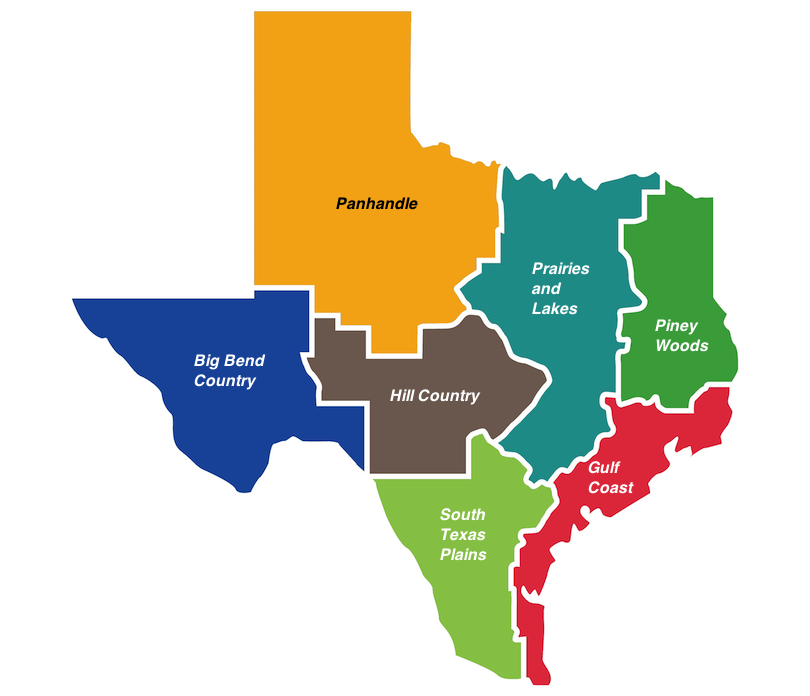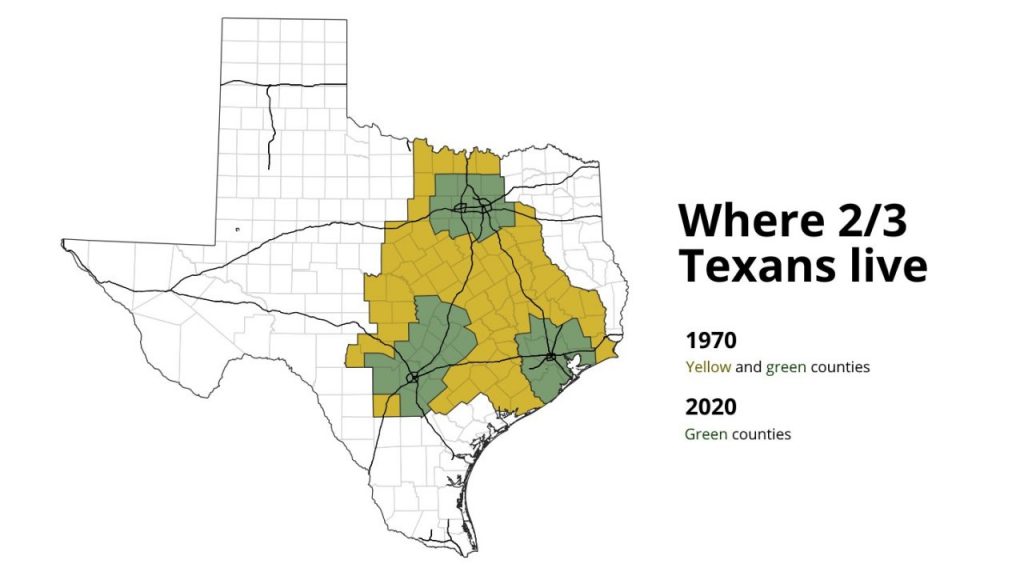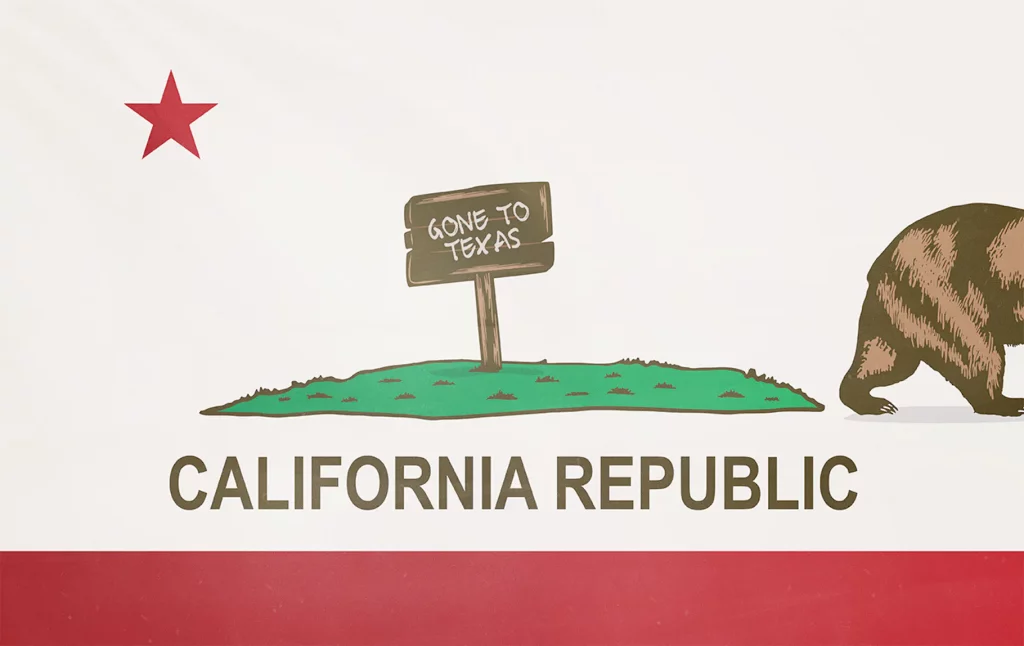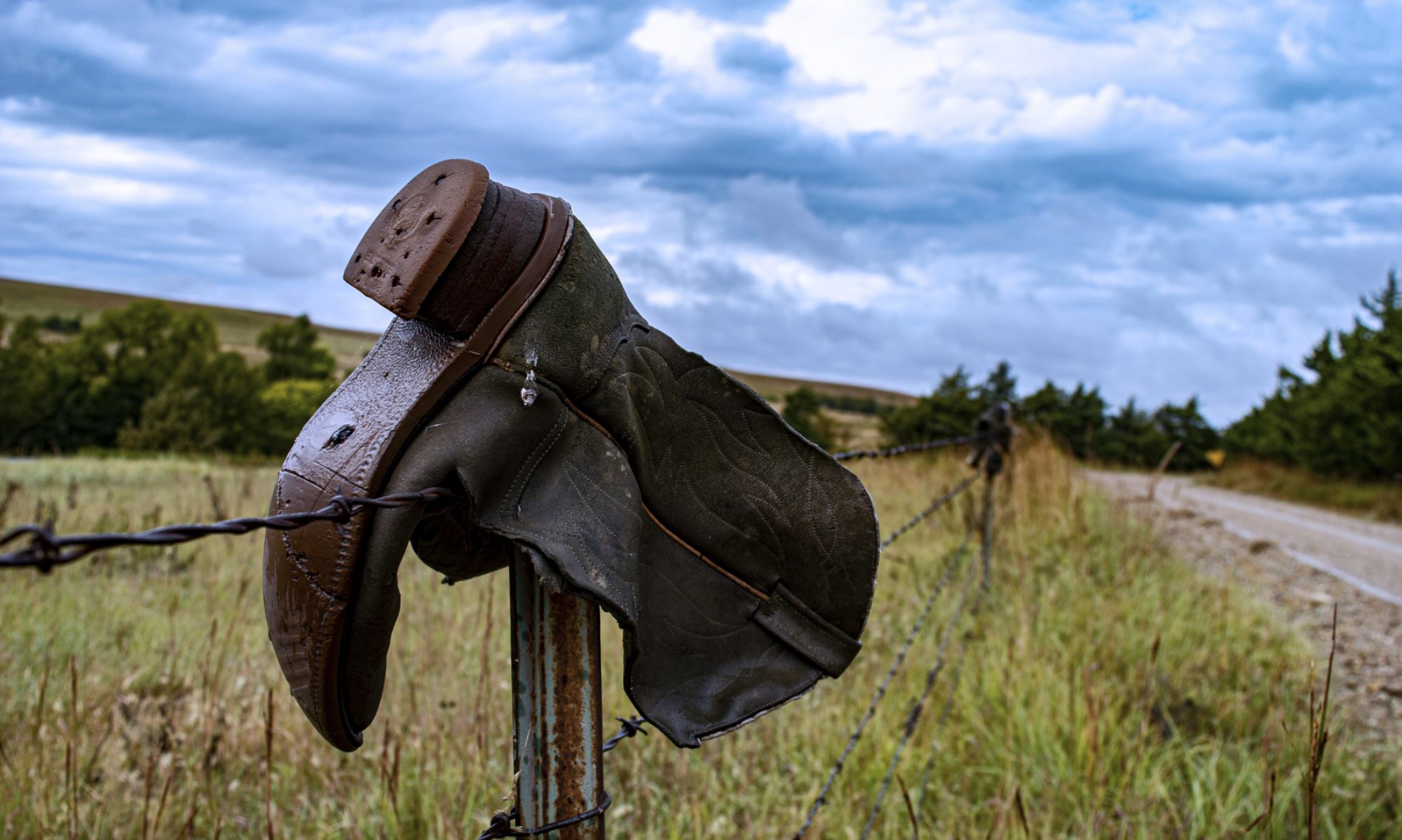Texas is a large, diverse state. Below, we will examine some of the characteristics of the Lone Star State today.
Size
Texas is the second largest state by geographic size, totaling 261,232 sq. miles (to get an idea of how big that really is, click here). One common way to characterize Texas’s geography is by falling into one of six distinct regions:

- Big Bend Country
- Panhandle
- Hill Country
- Prairies and Lakes
- Piney Woods
- South Texas Plains
- Gulf Coast
Texas’s large geographic size has shaped state politics and government. Vast distances have historically limited the ability of individuals to engage in the face-to-face interactions necessary to develop close-knit political institutions (which helps to explain, among other phenomenon, why party machines never really took root in Texas). Vast distances also translated into more costly campaigns, as those seeking office try to reach potential voters across larger election districts or, in some cases, across the state at large. This has, in part, deepened politicians’ reliance on connections with deep pockets as a source of campaign financing. Finally, the size of our state, in conjunction with the lack of political organization and frontier-derived elements of our state’s culture and traditions, produced a situation in which candidates were often rewarded for dramatic styles and attention-seeking antics (think W. Lee “Pappy” O’Daniel, former governor of Texas — the governor of Mississippi in the movie “O Brother, Where Art Thou?” is based on him). This type of political environment may make it easier for political outsiders to win political office (i.e., the OUTSIDER PHENOMENON).
Population
Over the past few decades, Texas has experienced rapid and continued population growth (+4.3 million from 2000 to 2010, and +4 million from 2010 to 2020). This rate of population growth outpaces many other states; for that reason, Texas gained four seats in the U.S. House of Representatives following the 2010 Census and an additional two seats following the 2020 Census.
Today, Texas is the second most populated state in the United States, with a population of over 29.1 million people, of which:
- 6.9% are under 5 years of age, 25.5% are under 18 years of age, and 12.9% are 65 years of age or older
- 50.3% are female
- 41.2% are white, 39.7% are Hispanic or Latino, 12.9% are Black or African American, 5.2% are Asian, 1.0% are American Indian or Alaskan Native, 0.1% are Native Hawaiian or Pacific Islander, and 2.1% are two or more races
- NOTE: Texas is one of seven states that are considered a MAJORITY-MINORITY STATE, because less than 50% of the population are non-Hispanic white persons
- 17% were foreign-born persons
The primary sources of Texas’s population growth from 2010-2020 were NATURAL INCREASES (i.e., birthrate) and DOMESTIC MIGRATION (i.e., moving to Texas from another state in the United States). This trend has recently shifted, with domestic migration now accounting for the majority of growth within the state.

Texas has the largest rural population and the second largest urban population of all the states. While there are still many rural areas in Texas, its population is increasingly residing in urban areas, with 83.7% of Texans living in urban areas in 2020. Three of the largest 10 U.S. cities are in Texas: Houston (#4, with a population of nearly 2.4 million); San Antonio (#7, with a population of nearly 1.6 million); and Dallas (#9, with a population of about 1.4 million). Two-thirds of Texans live in an area that extends between Dallas/Fort Worth, San Antonio, and Houston, known as the TEXAS TRIANGLE.
Texas is sometimes called the “buckle of the Bible Belt”: the majority of Texans are religious, with most religious Texans considering themselves either Catholic, Protestant, or Evangelical Protestant. Texas is among the most religious states (#11 in 2016, according to Pew Research Center).
In several important areas, Texans lag behind other citizens in other states:
- Citizen wealth — Texas’s per capita income and household ownership rate fall below the national average; Texas’s poverty rate is higher than the national average
- Citizen education — Texas falls in the bottom 1/3 of states when it comes to four-year high school graduation rates and percentage of the population age 25 and older who have a high school diploma and lags behind the national average on percentage of population age 25 and older who have a bachelor’s degree or an advanced degree
- Citizen participation — Texas ranks near the bottom of the list when it comes to various pathways of civic engagement, including voter registration, voting, donating, volunteering, contacting elected officials, and discussing government and politics
Want to Know More?
For more statistics about Texas, check out the U.S. Census’s Texas QuickFacts page.
For a graphical summary of the 2018 Texas Civic Health Index report, which includes facts regarding where Texas ranks on civic engagement compared to other states, click here.
Economy
Texas has transitioned over time from an economy based largely on agricultural products (cattle, cotton, and lumber), to one dominated by the oil industry, to the highly diversified economy that exists in the state today. Major industries today include energy, agriculture, manufacturing, and information technology.
Today, Texas’s GDP (GROSS DOMESTIC PRODUCT) is the second largest among all states ($2.6 trillion in 2023) and is larger than the GDP of some countries. Texas also comes in second among all states when it comes to the total number of jobs (14.09 million in Nov. 2023). Not only do we have a lot of jobs, but we also have a lot of job creation:
- According to the Bureau of Labor and Statistics (BLS), in 2023 Texas ranked #1 in job creation and #3 in over-the-year percent change
- According to the Texas Workforce Commission (TWC), December 2023 marked 34 months of uninterrupted job growth and new record highs for the number of jobs in Texas, the number of Texans working, and the size of the Texas labor force
“Texas has always been an export-based economy, with first cotton, then energy and now high-tech linking it to global markets” (The future is – Texas; Texas, 2002). Today, Texas leads in exports, with the highest export rate of all states ($315.9 billion in 2018, which made up 17.3% of the state’s GDP). The largest export product is oil and gas.

During Rick Perry’s time as governor, many businesses, including major automotive manufacturing and information technology companies, opened new locations and/or relocated their corporate headquarters to Texas. This trend has continued during Greg Abbott’s governorship — Tesla’s decision to construct the Gigafactory automotive manufacturing facility in Austin (and their more plans to construct the “Bobcat Project” facility next to the Gigafactory) is one of numerous examples of businesses choosing to expand their operations within our state. In total, over 150 business have moved or have announced they are moving to Texas since 2020; more than half of these businesses are moving from California.
This raises the question: why do businesses like Texas?
- favorable tax policies, including low taxes and generous subsidies
- business-friendly regulations
- low cost of living, corporate rent, and real estate
- large labor force
Given these factors, it comes as little surprise that in 2023, Texas was (yet again) named State of the Year by Business Facilities magazine, marking the fifth time Texas has received this award (more than any other state).
